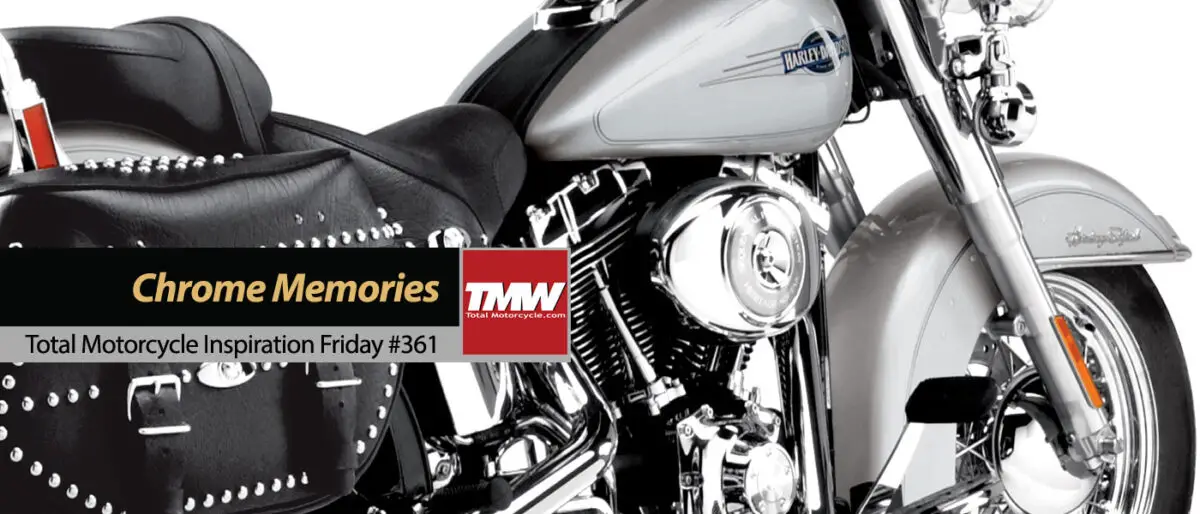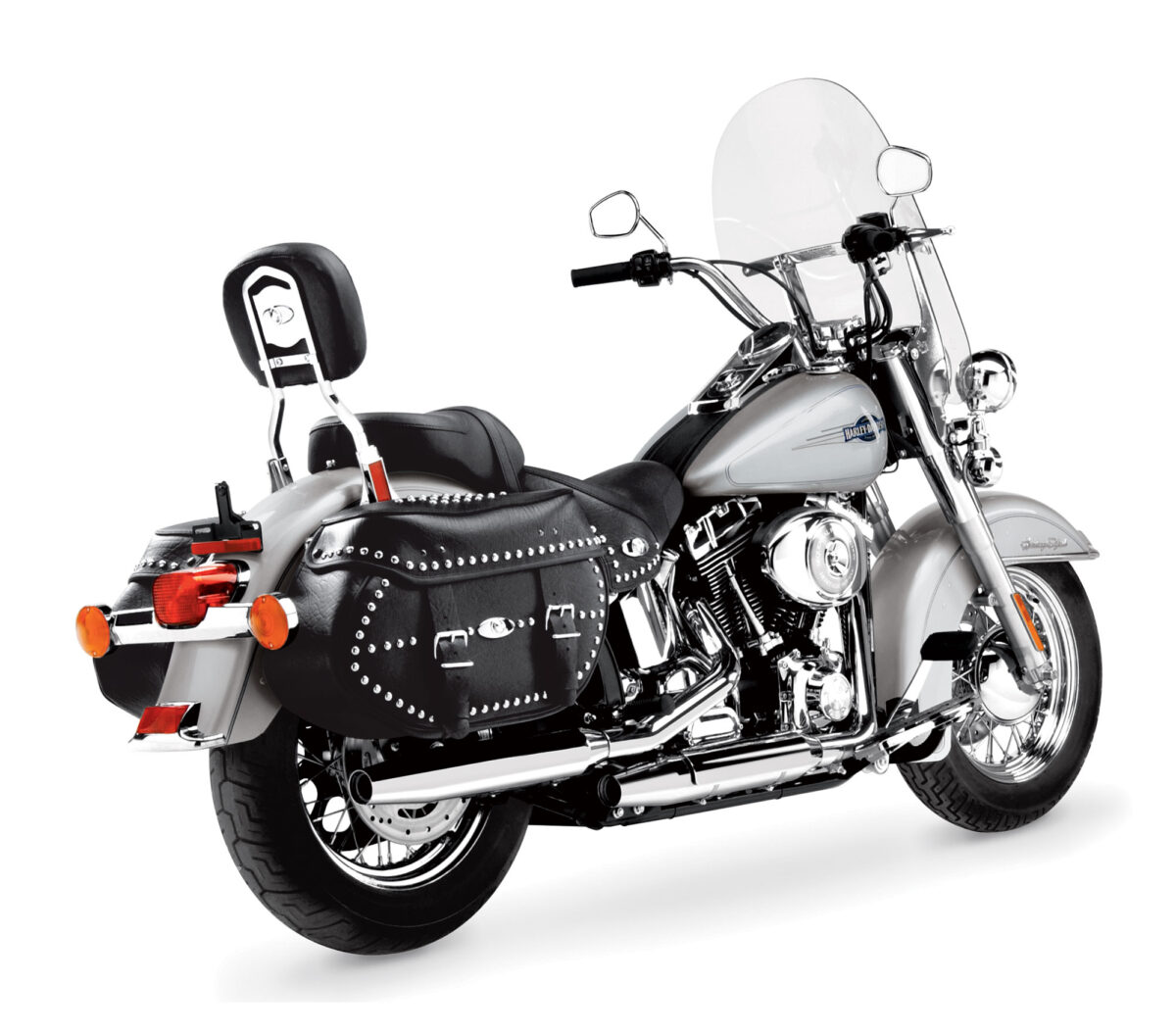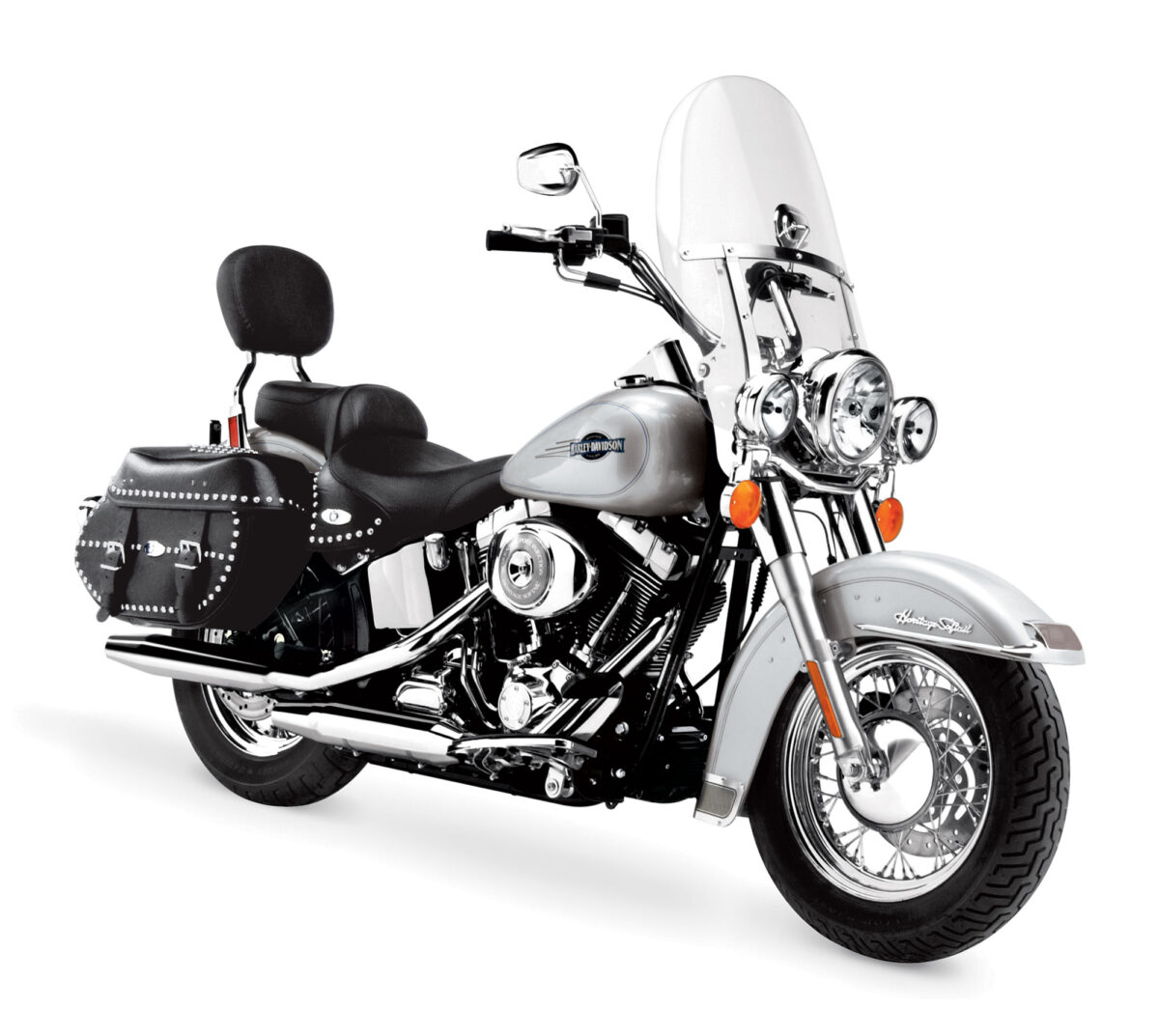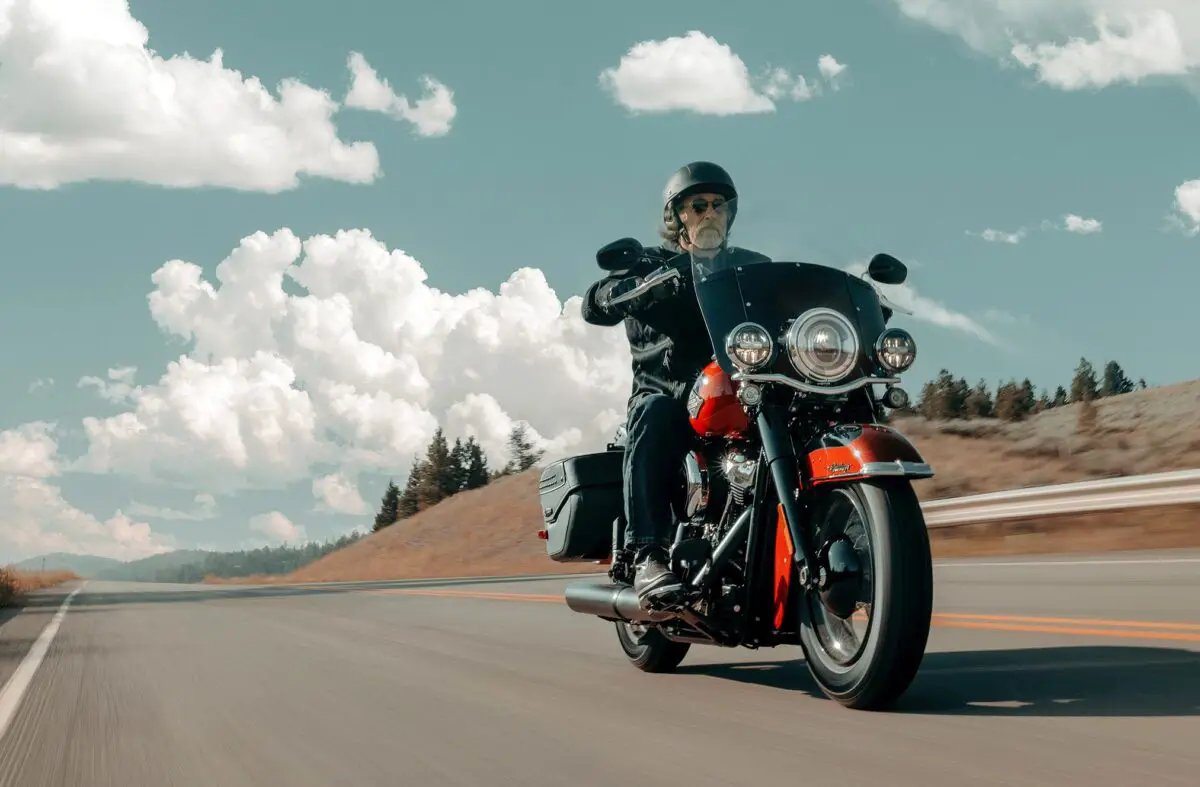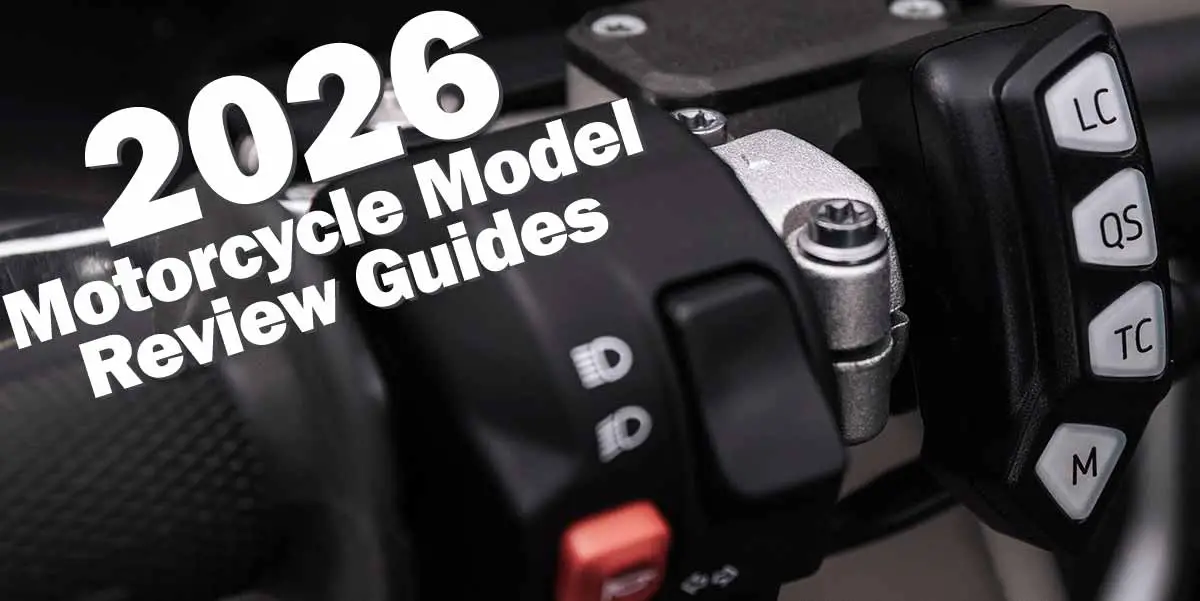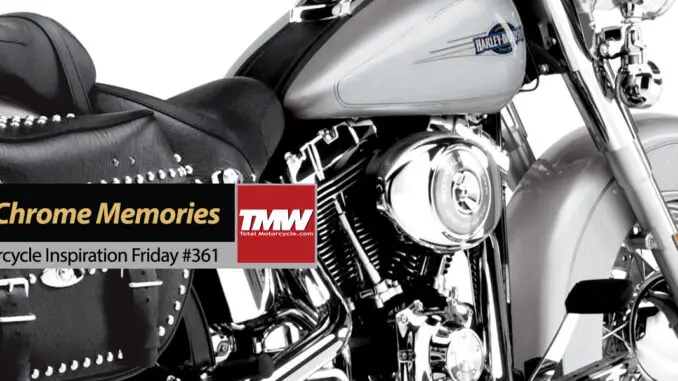
In 2005, Harley‑Davidson was at the height of its powers, and no bike captured that golden era better than the Heritage Softail Classic. Chrome‑laden, leather‑studded, and endlessly nostalgic, it became the brand’s best‑selling model and a symbol of freedom on two wheels. Twenty years later, TMW looks back at the machine that defined a generation and trace how its spirit still rides on today. Welcome to Inspiration Friday: Harley‑Davidson Heritage Softail Turns 20!
From the 2005 model to the 2025 model, that’s 20 great years to look back on!
While you are here, check out all our Harley-Davidson Motorcycle Model Review Guides from 2000 to 2026 (today).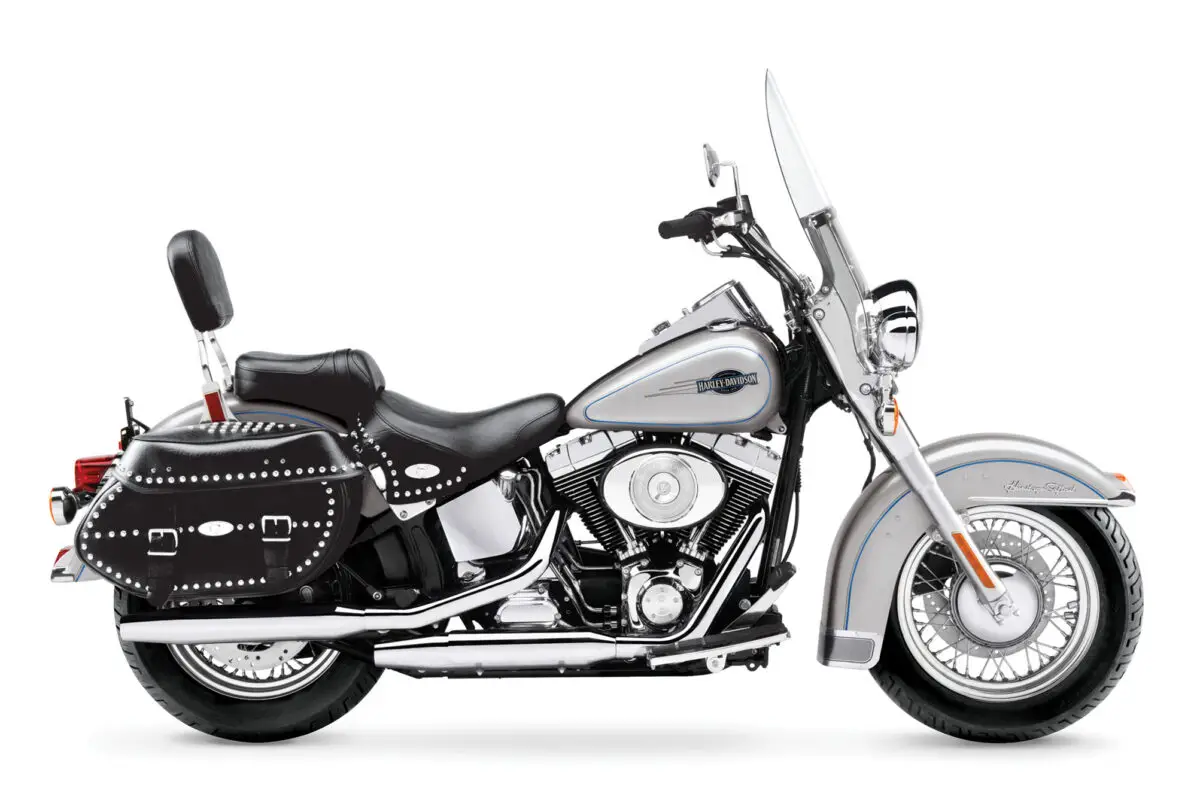
The Smell of Gasoline and Leather, 2005
It’s hard to believe now, but in 2005 Harley‑Davidson was at the absolute height of its powers. The Motor Company was not just a motorcycle manufacturer, it was a cultural juggernaut. Dealerships were bustling community centers, waiting lists stretched months long, and the brand’s mystique was so strong that riders were paying premiums above MSRP just to get their hands on Milwaukee iron.
The baby boomers who had grown up idolizing Marlon Brando in The Wild One and Peter Fonda in Easy Rider were now in their prime earning years. They had disposable income, they had the dream, and they wanted the garage centerpiece that symbolized freedom, rebellion, and Americana.
And at the very heart of that dream sat the 2005 Harley‑Davidson Heritage Softail Classic (FLSTC).
With its studded leather saddlebags, chrome passing lamps, detachable windshield, and floorboards, the Heritage Softail Classic looked like a time machine. It whispered of Route 66, roadside diners, and a simpler America. Yet beneath the nostalgia was modern reliability: the counter‑balanced Twin Cam 88B engine, rubber‑mounted comfort, and enough torque to pull you and a passenger across state lines without complaint.
The Heritage wasn’t just a motorcycle. It was Harley’s #1 best‑seller in the mid‑2000s, outselling even the mighty Electra Glide. It was the bike that bridged the gap between cruiser and tourer, between nostalgia and practicality.
Chapter One: Why the Heritage Ruled the Mid‑2000s
The Heritage Softail Classic’s dominance in 2005 wasn’t an accident. It was the result of a perfect storm of design, culture, and timing.
- Broad appeal: The Heritage looked like a classic dresser, but it wasn’t intimidating. Riders who wanted the “full Harley look” without the bulk of an Ultra Classic gravitated to it.
- Touring comfort without excess: Saddlebags, windshield, floorboards, all the essentials for long rides, without the weight of a full dresser.
- Price point: At ~$17,000 USD in 2005, it was attainable compared to the $20K+ touring rigs.
- Dealer reports: Industry data consistently placed the Heritage as Harley’s top retail seller in the U.S. market.
It was, in short, the Goldilocks Harley: not too big, not too small, just right.
Chapter Two: The World Around It
To understand why the Heritage resonated so strongly, you have to remember the world of 2005.
Gas was $2.30 a gallon in the U.S. The iPhone didn’t exist yet. Social media was in its infancy, Facebook was still limited to college students, YouTube had just launched, and MySpace was king.
Harley’s customer base was overwhelmingly Gen X and boomer, and the brand’s mystique was unchallenged. Motorcycling culture was booming. Sturgis was packed, Daytona Bike Week was a pilgrimage, and Harley dealerships were community hubs.
The Heritage Softail Classic fit perfectly into that world: a bike that looked like it had rolled out of 1955, but with the reliability to ride coast to coast in 2005.
Chapter Three: The Heritage Softail Classic in Detail
Specs Snapshot (2005 FLSTC)
| Category | Details |
|---|---|
| Engine | Twin Cam 88B, 1450cc, carb or EFI |
| Torque | 115 Nm @ 3000 rpm |
| Weight | 335 kg running order |
| Seat Height | 647 mm laden |
| Fuel Capacity | 18.9 L |
| MSRP (2005) | ~$17,000 USD (base) |
| Features | Studded leather saddlebags, detachable windshield, chrome passing lamps, floorboards |
The Twin Cam 88B was counter‑balanced, reducing vibration compared to earlier Harleys. Riders praised its smoothness at highway speeds, its torque for two‑up riding, and its reliability.
The styling was pure nostalgia: chrome everywhere, leather studded with conchos, whitewall tires, and wire‑spoked wheels. It was a bike that looked like it belonged in a Norman Rockwell painting, yet it could cruise at 75 mph all day long.
Chapter Four: Rider Impressions (2005–2006)
- Rider ratings: High marks for styling and comfort, lower for brakes and cornering clearance.
- Review: Called it “time‑tested design” with “lashing of chrome” and “intrinsic beauty.”
- Praised as a “budget tourer” with classic looks, though noted brakes and mod‑cons lagged.
- Forums said: Riders discussed ground clearance and touring comfort, often praising its two‑up capability.
One rider on summed it up: “It’s not the fastest, it’s not the lightest, but it’s the one that makes me smile every time I walk into the garage.”
Chapter Five: Other Strong Sellers in 2005
While the Heritage Softail Classic was the top seller, several other models were also very popular that year:
| Model | Why It Sold Well |
|---|---|
| Softail Deluxe (FLSTN) | New for 2005, retro styling, whitewalls, low seat. |
| Dyna Wide Glide (FXDWG) | Factory chopper look. |
| Electra Glide Ultra Classic (FLHTCU) | Flagship touring, long‑distance favorite. |
| Sportster 1200 Roadster (XL1200R) | Affordable entry, rubber‑mount redesign in 2004 boosted appeal. |
Harley‑Davidson in 2005 was at its sales peak era, with demand outstripping supply for many models. The Softail family dominated sales overall, with the Heritage Softail Classic leading the pack. Touring models like the Electra Glide and Road King were also strong, but the Heritage consistently outsold them.
Chapter Six: The Heritage Through the Years (2005–2025)
2005–2006: The Peak
- Twin Cam 88B engine, carb or EFI.
- Still Harley’s #1 seller.
2007–2009: The Street Glide Rises
- The new Street Glide (FLHX) began to steal the spotlight.
- Heritage still strong, but younger riders wanted baggers with tunes and fairings.
2010–2016: Holding the Line
- Heritage remained a staple, though sales shifted toward touring models.
- Incremental updates: new paint, minor refinements.
2017–2018: The Big Shift
- Harley introduced the Milwaukee‑Eight engine and a new Softail chassis.
- The Heritage Softail Classic was reborn as the Heritage Classic.
- Styling leaned more modern, with blacked‑out options alongside chrome.
2019–2025: The Modern Heritage Classic
- Available with 107ci and 114ci Milwaukee‑Eight engines.
- Still carries saddlebags and windshield, but with LED lighting, ABS, and modern suspension.
- By 2025, it’s positioned as a “light tourer”, the spiritual successor to the 2005 Heritage, but with 21st‑century tech.
Chapter Seven: Would the 2005 Heritage Work Today?
It’s a question that inevitably comes up when Total Motorcycle looks back at a machine that defined an era: if Harley rolled the 2005 Heritage Softail Classic onto showroom floors in 2025, unchanged, would it sell?
The answer is complicated.
On one hand, the 2005 Heritage would be a nostalgia bomb. Riders who came of age in the early 2000s would see it as a time capsule: carbureted charm, chrome everywhere, studded leather, and that unmistakable Twin Cam rumble. There’s a growing subculture of riders who crave “analog” motorcycles, machines without ride modes, TFT screens, or electronic nannies. For them, the 2005 Heritage would be irresistible.
But for the mainstream buyer? It would feel dated. Today’s riders expect ABS, traction control, LED lighting, and infotainment. They want USB ports, Bluetooth connectivity, and suspension that can handle both highways and pothole‑ridden city streets. The 2005 Heritage, charming as it is, would feel like a relic.
The truth is, Harley knows this. That’s why the modern Heritage Classic exists. It carries the DNA of the 2005 bike, windshield, saddlebags, floorboards, classic silhouette, but updates it with Milwaukee‑Eight power, ABS, LED lighting, and modern suspension. It’s the compromise: nostalgia with safety and performance.
So would the 2005 Heritage work today? Yes, as a collector’s piece, a weekend toy, or a retro‑themed special edition. But as a mainstream best‑seller? The world has moved on.
If You Parked All Three Side by Side…
Imagine rolling a 2005 Heritage Softail Classic, a 2015 Heritage Softail Classic, and a 2025 Heritage Classic into the same garage. At first glance, they’re clearly family, the stance, the saddlebags, the windshield, the unmistakable Harley silhouette. But stand there a moment longer, and the decades begin to speak.
The 2005 Heritage gleams like a time capsule. Chrome everywhere, studded leather saddlebags with conchos, whitewall tires, and a carbureted heartbeat that smells faintly of gasoline and nostalgia. It’s the bike that looks like it just rumbled out of a Norman Rockwell painting, ready for Route 66.
The 2015 Heritage sits beside it like a younger sibling who’s grown into their confidence. The Twin Cam 103B engine adds muscle, the 6‑speed transmission hums smoother, and ABS is quietly waiting in the background. The chrome and studs are still there, but the bike feels more refined, more polished, a bridge between eras.
And then there’s the 2025 Heritage Classic. At first, it looks almost too modern, LED headlamp glowing, blacked‑out trim options, sleeker saddlebags. But look closer, and the DNA is unmistakable. The windshield still detaches with a click, the floorboards still promise all‑day comfort, and the Milwaukee‑Eight engine still delivers that low‑end torque Harley riders crave. It’s the same spirit, dressed for a new century.
Side by side, the three bikes tell a story: not of reinvention, but of careful evolution. Harley didn’t throw away the Heritage’s soul, it polished it, tuned it, and carried it forward. The 2005 whispers of the past, the 2015 balances tradition with progress, and the 2025 proves that some designs are timeless, even as the world changes around them.
Chapter Eight: The Competition Then and Now
In 2005, Harley’s rivals were circling. The Japanese manufacturers were still heavily invested in the cruiser market. Honda had the VTX 1300 and 1800, Yamaha offered the Road Star and Royal Star, Kawasaki had the Vulcan 1600, and Suzuki was pushing the Boulevard line. All of them chased the same formula: big V‑twin, classic styling, long‑haul comfort.
But none of them had Harley’s mystique. Riders might admit that a Honda VTX was smoother, or a Yamaha Road Star was cheaper, but when it came to pulling into a diner parking lot, nothing turned heads like a Harley. The Heritage Softail Classic wasn’t just a motorcycle, it was a statement.
Fast‑forward to 2025, and the landscape looks very different. The Japanese brands have largely retreated from the heavyweight cruiser market. Honda’s Rebel 1100 is a modern, parallel‑twin cruiser aimed at a different demographic. Yamaha and Suzuki have scaled back their big‑twin offerings. Kawasaki’s Vulcan 1700 soldiers on, but it’s a niche player.
The real competition today comes from Indian Motorcycle. The Indian Chief and Springfield echo the Heritage’s formula: classic styling, saddlebags, windshield, and long‑haul comfort. Indian has positioned itself as the alternative to Harley, and in many ways, it’s the Heritage’s truest rival in 2025.
Chapter Nine: Harley’s Top Sellers, 2000–2010
To understand the Heritage’s place in Harley history, it helps to look at the numbers. Here’s a year‑by‑year snapshot of Harley’s top‑selling models in the U.S. market during the first decade of the 2000s:
| Year | Top Harley Model | Notes |
|---|---|---|
| 2000 | Heritage Softail Classic | Peak nostalgia, Softail dominance. |
| 2001 | Heritage Softail Classic | Still #1. |
| 2002 | Heritage Softail Classic | Consistent leader. |
| 2003 | Heritage Softail Classic | 100th Anniversary, demand outstripped supply. |
| 2004 | Heritage Softail Classic | Rubber‑mount Sportsters gained traction, but Heritage led. |
| 2005 | Heritage Softail Classic | Harley’s #1 retail seller. |
| 2006 | Heritage Softail Classic | Still leading, Street Glide introduced. |
| 2007 | Street Glide (FLHX) | Began overtaking Heritage. |
| 2008 | Street Glide | Became Harley’s new #1. |
| 2009 | Street Glide | Cemented dominance. |
| 2010 | Street Glide | Heritage still strong, but baggers ruled. |
This table tells a story. For most of the 2000s, the Heritage was king. But by the late decade, the Street Glide had risen, capturing younger riders who wanted baggers with tunes, fairings, and a more modern vibe. The Heritage remained beloved, but the crown had passed.
Chapter Ten: The Heritage’s Legacy
The Heritage Softail Classic was more than a motorcycle. It was a cultural artifact. It captured the essence of Harley’s golden era, when chrome gleamed brightest and the open road called loudest.
Its DNA lives on in the 2025 Heritage Classic, which still carries saddlebags, windshield, and that unmistakable silhouette. But the world has changed. Riders now want Bluetooth, ABS, and blacked‑out finishes. The Heritage has adapted, but its soul remains the same.
For many riders, the Heritage is the bike that got them into Harley. It was approachable, comfortable, and iconic. It was the bike you could ride to Sturgis, park on Main Street, and know you belonged.
Heritage Classic Evolution: 2005 vs 2015 vs 2025
| Spec / Feature | 2005 Heritage Softail Classic (FLSTC) | 2015 Heritage Softail Classic (FLSTC) | 2025 Heritage Classic (FLHCS) |
|---|---|---|---|
| Engine | Twin Cam 88B, 1450cc, carb or EFI | Twin Cam 103B, 1690cc, fuel‑injected | Milwaukee‑Eight 114, 1868cc, fuel‑injected |
| Power / Torque | ~67 hp / 85 lb‑ft @ 3000 rpm | ~75 hp / 95 lb‑ft @ 3000 rpm | ~94 hp / 119 lb‑ft @ 3000 rpm |
| Transmission | 5‑speed | 6‑speed Cruise Drive | 6‑speed Cruise Drive |
| Weight (running order) | ~739 lbs (335 kg) | ~738 lbs (335 kg) | ~728 lbs (330 kg) |
| Seat Height (laden) | 25.5 in (647 mm) | 25.5 in (648 mm) | 26.3 in (668 mm) |
| Fuel Capacity | 5.0 gal (18.9 L) | 5.0 gal (18.9 L) | 5.0 gal (18.9 L) |
| Brakes | Single front disc, rear disc | Dual front discs, ABS optional | Dual front discs, ABS standard |
| Lighting | Halogen headlamp, passing lamps | Halogen headlamp, passing lamps | LED headlamp, DRLs, LED signals |
| Suspension | Hidden rear shocks (Softail look) | Hidden rear shocks, improved damping | New Softail mono‑shock, cartridge fork |
| Electronics | None (analog gauges only) | Basic trip computer, optional ABS | ABS, traction control, cruise, USB, LED dash |
| Styling | Chrome, studded leather, nostalgic dresser | Chrome, studded leather, anniversary trims | Chrome or blacked‑out options, sleeker bags |
| MSRP (base, USD) | ~$17,000 | ~$18,500 | ~$22,500 |
What the Table Shows
- 2005: Pure nostalgia with just enough modern reliability.
- 2015: Incremental updates, bigger engine, 6‑speed, optional ABS, but still very much the same bike.
- 2025: A true evolution. Same silhouette, but with modern safety, electronics, and performance baked in.
The table makes it clear: Harley has carefully modernized the Heritage without losing its DNA. The saddlebags, windshield, and classic stance remain, but the guts have kept pace with rider expectations.
Epilogue: Chrome Memories
Looking back 20 years, the 2005 Heritage Softail Classic was Harley‑Davidson’s crown jewel. It was the bike that everyone wanted, the bike that defined an era.
Today, it stands as a reminder of where we were, and a benchmark for where we are. The Heritage has evolved, but it hasn’t lost its essence. It’s still the bike that bridges past and present, nostalgia and modernity.
📌 Bottom line: The Heritage Softail Classic was Harley’s best‑seller in 2005 because it was the perfect mix of style, comfort, and accessibility. Twenty years later, its legacy endures in the Heritage Classic, proving that some designs are timeless.

Michael Le Pard (“Mr. Totalmotorcycle”) is the Founder of Total Motorcycle, the world’s largest motorcycle information site, trusted by over 430 million riders since 1999. With over 34 years of experience in motorcycles, gear and rider culture, he has built a global community dedicated to empowering and inspiring motorcyclists.
Total Motorcycle remains his passion project. Combining expert research, hands‑on knowledge and a commitment to helping riders make informed decisions about bikes, gear and safety worldwide.


